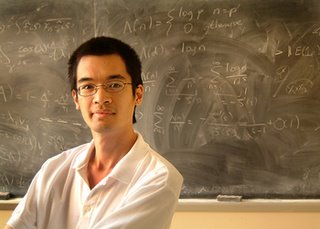Fields Medal 2006
 (from top to bottom) Terence Tao of Univ California, Los Angeles, Grigory Perelman of Russia, Wendelin Werner of Univ of Paris-Sud, Orsay, Andrei Okounkov of Princeton Univ were awarded the Fields Medal during the International Congress of Mathematicians 2006 in Madrid (photo courtsey: International Congress for Mathematicians)
(from top to bottom) Terence Tao of Univ California, Los Angeles, Grigory Perelman of Russia, Wendelin Werner of Univ of Paris-Sud, Orsay, Andrei Okounkov of Princeton Univ were awarded the Fields Medal during the International Congress of Mathematicians 2006 in Madrid (photo courtsey: International Congress for Mathematicians)The Fields Medal is often described as mathematics’ equivalent to the Nobel Prize. The medal was conceived by John Charles Fields, a Canadian mathematician, “in recognition of work already done and as an encouragement for further achievements on the part of the recipient.”

The medal was first awarded in 1936. The award should usually be limited to mathematicians 40 years old or younger and is given every four years, and several can be awarded at once. This year we got 4 recipients:
(i) Grigory Perelman, a reclusive Russian mathematician who solved a key piece in a century-old puzzle known as the Poincaré conjecture. But Dr. Perelman refused to accept the medal, as he has other honors, and he did not attend the ceremonies at the International Congress of Mathematicians in Madrid. He also turned down job offers from Princeton, Stanford and other universities.
(ii) Terence Tao of University of California, Los Angeles. Dr. Tao is a native of Australia and one of the youngest Fields Medal winners ever at age 31, has worked in several different fields, producing significant advances in the understanding of prime numbers, techniques tha
 t might lead to simplifying the equations of Einstein’s theory of general relativity and the equations of quantum mechanics that describe how light bounces around in a fiber optic cable.
t might lead to simplifying the equations of Einstein’s theory of general relativity and the equations of quantum mechanics that describe how light bounces around in a fiber optic cable.(iii) Wendelin Werner of the University of Paris-Sud in Orsay. Dr. Werner was born in Germany in 1968. He, like Dr. Tao, has worked at the intersection of mathematics and physics, describing phenomena like percolation and shapes produced by the random paths of Brownian motion.
(iv) Andrei Okounkov of Princeton University. Dr. Okounkov, born in 1969 in Moscow, was recognized for work that tied together different fields of mathematics that had seemed unrelated. Dr. Okounkov’s work has found use in describing the changing surfaces of melting crystals. The boundary between melted and non-melted is created randomly, but the random process inevitably produces a border in the shape of a heart.
To learn more about this award, visit the Field Medal site.


0 Comments:
Post a Comment
<< Home